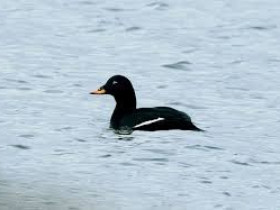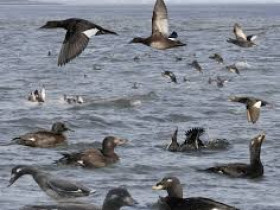Velvet Scoter
Melanitta fusca
51-58cm
Appearance of the Velvet Scoter
The Velvet Scoter is a sea duck larger than its cousin, the Common Scoter, and close in size to the Mallard. It has a thick neck, a pointy tail and a long bill comparable to the Eider's. The sexes have some distinct differences, though both have white at the back edge of their wings which is visible in flight, and occasionally partly seen when swimming. The velvety black plumage of the male means the white just below his eye stands out - this patch can also be used to discern drakes from female birds. His bill is blackish-yellow and he has a small knob at its base. The female is a dark, sooty-brown; she has pale patch on her cheek and a light smudge at the base of her otherwise dark bill.
Velvet Scoter Habitat
This is a non-breeding visitor who arrives in Britain and Ireland from its nesting grounds in Scandinavia. Can usually be found in the region in marine areas with sandy seabeds; rough ocean and coasts exposed to the elements are favoured by these birds. More sheltered bays are acceptable provided there's enough food. During the breeding season these birds are more likely to inhabit lakes, pools and rivers.
Character
These birds often associate with Common Scoters, otherwise they can be found in small groups. They cock their tail and dive with wings semi-open and without jumping; feeding sometimes occurs in rough water near to rocks.
What does the Velvet Scoter eat?
Shellfish, particularly blue mussels, cockles and dog whelks, are preferred foods; it dives to find these. Diet also includes crabs, sea urchins, small fish, insect larvae and some plant matter.
Velvet Scoter Breeding
Birds occasionally summer in the region, though there's no evidence to prove they breed in Britain or Ireland. Birds pair up in flocks in winter; the male deserts while the female incubates and young birds can fly after 50 days.
Population
Primarily a winter visitor, this bird is most common on the east coast, especially Scotland, Norfolk, and north-east England; approximately 2500 individual birds are present there between late September to April. Migrations may be seen in small numbers on the south coast.
Observation Tips for the Velvet Scoter
This bird is more difficult to find than its cousin, but it's worth checking the flocks of Common Scoters for a few individual Velvets. For its own flocks, northeast Scotland, especially the Moray Firth, is worth checking for these winter visitors.
Voice
A quiet bird, particularly in the UK region, though a raspy croaking occurs in flocks during winter.


